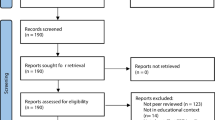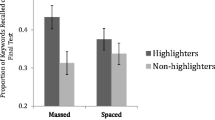Abstract
The notion of flow of a proof encapsulates mathematical, didactical, and contextual aspects of proof presentation. A proof may have different flows, depending on the lecturer’s choices regarding its presentation. Adopting Perelman’s New Rhetoric (PNR) as a theoretical framework, we designed methods to assess aspects of the flow of a proof. We present a case study from a Number Theory class at the beginning undergraduate level, focusing on an intervention concerning one lesson given in two consecutive years. The intervention consisted of a discussion with the lecturer about findings from Year-1 and potential changes in the flow of the proof before the Year-2 lesson. We analyze two aspects of the flow of the proof: the scope and organization of the argumentation and the presence (in the PNR sense) of different elements. Our analysis revealed that the intervention caused global and local changes in the flow and that PNR enables us to capture these changes.






Similar content being viewed by others
Notes
In the Toulmin schemes, the sequence of data and claims is numbered logically, e.g., claim C1 is derived from data D, claim C2 is derived from C1, and so on. However, the warrants, backups, and refutations are numbered in chronological order, in order to emphasize the temporal dimension of the argumentation.
References
Alcock, L. (2010). Mathematicians’ perspectives on the teaching and learning of proof. In F. Hitt, D. Holton, & P. W. Thompson (Eds.), Research in collegiate mathematics education VII (pp. 63–92). Providence, RI: AMS, CBMS.
Alcock, L., Hodds, M., Roy, S., & Inglis, M. (2015). Investigating and improving undergraduate proof comprehension. Notices of the American Mathematical Society, 62, 741–752.
Fukawa-Connelly, T., Johnson, E., & Keller, R. (2016). Can math education research improve the teaching of abstract algebra? Notices of the American Mathematics Society, 63, 276–281.
Fukawa-Connelly, T. P., & Newton, C. (2014). Analyzing the teaching of advanced mathematics courses via the enacted example space. Educational Studies in Mathematics, 87, 323–349.
Gabel, M., & Dreyfus, T. (2013). The flow of a proof—The example of the Euclidean algorithm. In M. Lindmeier & A. Heinze (Eds.), Proceedings of the 37th International Conference for the Psychology of Mathematics Education (Vol. 2, pp. 321–328). Kiel, Germany: PME.
Grundey, S. (2014). Beweisvorstellungen und eigenständiges Beweisen: Entwicklung und vergleichend empirische Untersuchung eines Unterrichtskonzepts am Ende der Sekundarstufe. Wiesbaden: Springer, Fachmedien, Perspektiven der Mathematikdidaktik.
Hemmi, K. (2008). Students’ encounter with proof: The condition of transparency. ZDM - The International Journal on Mathematics Education, 40, 413–426.
Hemmi, K. (2010). Three styles characterising mathematicians’ pedagogical perspectives on proof. Educational Studies in Mathematics, 75, 271–291.
Lai, Y., & Weber, K. (2014). Factors mathematicians profess to consider when presenting pedagogical proofs. Educational Studies in Mathematics, 85, 93–108.
Larsen, S., & Zandieh, M. (2008). Proofs and refutations in the undergraduate mathematics classroom. Educational Studies in Mathematics, 67, 205–216.
Lew, K., Fukawa-Connelly, T. P., Mejía-Ramos, J. P., & Weber, K. (2016). Lectures in advanced mathematics: Why students might not understand what the mathematics professor is trying to convey. Journal for Research in Mathematics Education, 47, 162–198.
Mason, J. (1998). Enabling teachers to be real teachers: Necessary levels of awareness and structure of attention. Journal of Mathematics Teacher Education, 1, 243–267.
Mejia-Ramos, J. P., & Inglis, M. (2009). Argumentative and proving activities in mathematics education research. In F. L. Lin, F. J. Hsieh, G. Hanna, & M. de Villiers (Eds.), Proceedings of the ICMI Study 19 Conference: Proof and Proving in Mathematics Education (Vol. 2, pp. 88–93). Taipei, Taiwan: PME.
Mills, M. (2014). A framework for example usage in proof presentations. The Journal of Mathematical Behavior, 33, 106–118.
Perelman, C., & Olbrechts-Tyteca, L. (1969). The new rhetoric: A treatise on argumentation (J. Wilkinson & P. Weaver, Trans.). Notre Dame, IN: University of Notre Dame.
Pinto, A. (2013). Variability in university mathematics teaching: A tale of two instructors. In B. Ubuz, Ç. Haser, & M. A. Mariotti (Eds.), Proceedings of the Eighth Congress of the European Society for Research in Mathematics Education (pp. 2416–2425). Ankara, Turkey: Middle East Technical University.
Rav, Y. (1999). Why do we prove theorems? Philosophia Mathematica, 7, 5–41.
Roy, S., Alcock, L., & Inglis, M. (2010). Undergraduates’ proof comprehension: A comparative study of three forms of proof presentation. Retrieved from http://sigmaa.maa.org/rume/crume2010/Archive/Roy%20et%20al.pdf
Speer, N. M., Smith, J. P., & Horvath, A. (2010). Collegiate mathematics teaching: An unexamined practice. Journal of Mathematical Behavior, 29, 99–114.
Stylianides, A. J., & Stylianides, G. J. (2009). Proof constructions and evaluations. Educational Studies in Mathematics, 72, 237–253.
Thurston, W. P. (1994). On proof and progress in mathematics. Bulletin of the American Mathematical Society, 30, 161–177.
Toulmin, S. E. (1958). The uses of argument. Cambridge, UK: Cambridge University Press.
Weber, K. (2004). Traditional instruction in advanced mathematics courses: A case study of one professor’s lectures and proofs in an introductory real analysis course. Journal of Mathematical Behavior, 23, 115–133.
Weber, K. (2012). Mathematicians’ perspectives on their pedagogical practice with respect to proof. International Journal of Mathematical Education in Science and Technology, 43, 463–482.
Weber, K., Hanna, G., Harel, G., Kidron, I., Selden, A., & Selden, J. (2013). Justification and proof in mathematics and mathematics education. In M. Fried & T. Dreyfus (Eds.), Mathematics and mathematics education: Searching for common ground (pp. 237–257). Springer: Advances in Mathematics Education series.
Weinberg, A., Wiesner, E., & Fukawa-Connelly, T. (2016). Mathematics lectures as narratives: Insights from network graph methodology. Educational Studies in Mathematics, 91, 203–226.
Acknowledgements
We would like to thank an anonymous reviewer for encouraging us and helping us to situate our study in the wider research landscape.
Author information
Authors and Affiliations
Corresponding author
Electronic supplementary material
Below is the link to the electronic supplementary material.
ESM 1
(DOCX 229 kb)
Rights and permissions
About this article
Cite this article
Gabel, M., Dreyfus, T. Affecting the flow of a proof by creating presence—a case study in Number Theory. Educ Stud Math 96, 187–205 (2017). https://doi.org/10.1007/s10649-016-9746-z
Published:
Issue Date:
DOI: https://doi.org/10.1007/s10649-016-9746-z




